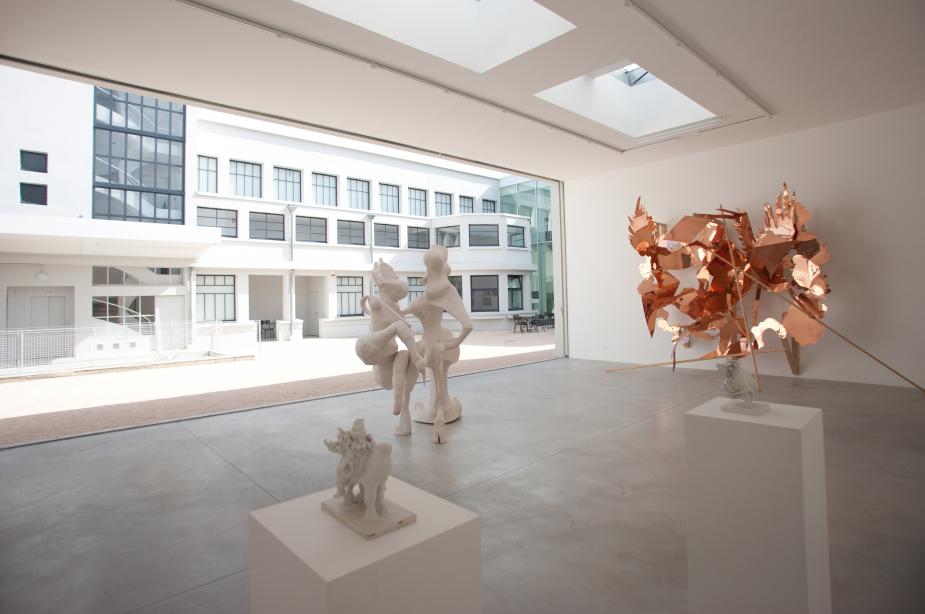History
Established since 2011 in a specifically designed 4,000 square-meter building by Japanese architect Shigeru Ban, the history of Le Consortium began in 1977 on the first floor of an alternative bookstore, and later on in a former appliance store located at the back of a courtyard on the central market square in Dijon, Burgundy. Here, young academics carried out their ambition to exhibit the art of their time. Together with a handful of people passionate about art, its founders Xavier Douroux and Franck Gautherot organized exhibitions from the late 1970s on with avant-garde artists such as Christian Boltanski in 1978, Hans Peter Feldmann in 1979, Annette Messager in 1980, Cindy Sherman and Daniel Buren in 1982, Carl Andre and Richard Prince in 1983, Bertrand Lavier and Hans Haacke in 1986.
As early as the end of the 1980s, Le Consortium questioned the nature and conventions inherent to exhibitions through an exhibition itself, Une Autre Affaire, an “exhibition of exhibitions” reenacting in Dijon and in almost real time the group shows organized in the United States by Peter Halley, Bob Nickas, and Steven Parrino. With Le Choix des Femmes in 1990, it also organized an exhibition which led four male curators to each invite four women artists.
After having exhibited minimal and conceptual art, the Pictures Generation and abstract experiments that furthered the work of neo-geo artists in the 1980s, Le Consortium in the 1990s accompanied the emergence of a new generation of artists, from the Young British Artists––Liam Gillick, Angela Bulloch, and Gillian Wearing––to Dominique Gonzalez-Foerster, Maurizio Cattelan, Carsten Höller, Pierre Huyghe, Ugo Rondinone, Jorge Pardo and Philippe Parreno.
Recently hailed by The New York Times [1] as “the under-the-radar French museum that quietly predicts art’s next big thing,” Le Consortium has since the 2000s organized the first exhibitions in France of a number of American artists such as Christopher Wool, Kelley Walker, Rachel Feinstein, Josh Smith, Rachel Harrison, Wade Guyton, Joe Bradley, Roe Ethridge, Brian Calvin, Alex Israel, Oscar Tuazon or Lari Pittman while also dedicating retrospectives to Lynda Benglis, Dadamaino, Luigi Ontani, and Phillip King.
Le Consortium was the curator of the French Pavilion that earned Pierre Huyghe a Golden Lion at the 2001 Venice Biennale, and of C’est arrivé demain, the 7th Lyon Biennale of Contemporary Art in 2003. It has participated in the “rediscovery” of Yayoi Kusama’s work with the presentation of a large retrospective in 2000, which later traveled to the Maison du Japon in Paris before going to Denmark, Austria, and Korea. In addition, Le Consortium has also organized exhibitions in Anyang, Seoul, and at the Centre Georges Pompidou with a presentation of its collection.
Le Consortium’s Collection, now permanently exhibited on the top floor of the building, includes more than 350 works. Essentially comprised of gifts from the artists who have exhibited there, it forms a true memory of these exhibitions. It includes works by On Kawara, Cady Noland, Dan Graham, Louise Lawler, Allan McCollum, Rirkrit Tiravanija, Oscar Tuazon, Fredrik Værslev, Michael Williams, as well as important bodies of work by Bertrand Lavier, John Armleder, Steven Parrino and Olivier Mosset, among other artists.
Beyond exhibitions, artists have made a dialogue partner out of Le Consortium, and sometimes a producer. In the 1980s they inspired the conception of a publishing house for their catalogs (Les presses du Réel) and in the 1990s a film production company (Anna Sanders Films) with the aim of inventing a “cinema for exhibitions.”
Now the most important distributor in France for books devoted to contemporary arts, Les Presses du Réel has become over the years an important independent publishing house, publishing everything deemed of importance such as the writings of Charles Fourier, an 18th century French philosopher, as well as monographs on contemporary artists and architects. Anna Sanders Films has produced films such as Uncle Boonmee Who Can Recall His Past Lives, which won the Palme d’Or at the Cannes Film Festival in 2010, as well as the recent highly successful Le Portrait Interdit by Charles de Meaux, and “cinema for exhibitions” films by Pierre Huyghe and Dominique Gonzalez-Foerster
In collaboration with the Fondation de France, Le Consortium is the facilitator for the Nouveaux Commanditaires / New Patrons program, which allows individuals to band together around a specific issue or cause and commission an artist to make a piece centered on their concern. Many projects have been produced, with for example Oscar Tuazon creating a monumental artwork in homage to the Commandos d’Afrique in Belfort, or Christopher Wool a new group of stained glass windows for the Priory Church of La Charité-sur-Loire in Burgundy. With the prospect of the World Heritage site listing of the Burgundy vineyards, Le Consortium has joined forces with the Romanée-Conti Estate with a project to transform the former fermenting room of the Princes de Conti into an exhibition space devoted to contemporary art. Since then, it has organized exhibitions with Bertrand Lavier, Thomas Houseago, Yan Pei Ming, Kim Gordon, and Rodney Graham at the Académie Conti.
The fact that Le Consortium’s founders, who were joined by Eric Troncy in 1995 and from 2000 by Seungduk Kim in the direction team and later by Stéphanie Moisdon and Anne Pontégnie — have remained its artistic directors for forty years, thereby offering for a public structure dedicated to contemporary art a form of permanence without equal in the world, allows for an uninterrupted dialog to be established with artists. This dialog often continues throughout their careers, making Le Consortium an exacting laboratory and space for esthetic debate, with exhibitions as its language.
[1] The New York Times, June 21, 2016
